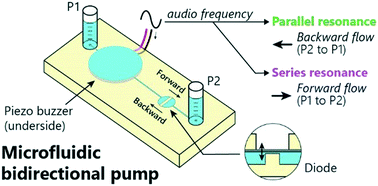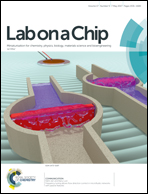Frequency tuning allows flow direction control in microfluidic networks with passive features†
Abstract
Frequency tuning has emerged as an attractive alternative to conventional pumping techniques in microfluidics. Oscillating (AC) flow driven through a passive valve can be rectified to create steady (DC) flow, and tuning the excitation frequency to the characteristic (resonance) frequency of the underlying microfluidic network allows control of flow magnitude using simple hardware, such as an on-chip piezo buzzer. In this paper, we report that frequency tuning can also be used to control the direction (forward or backward) of the rectified DC flow in a single device. Initially, we observed that certain devices provided DC flow in the “forward” direction expected from previous work with a similar valve geometry, and the maximum DC flow occurred at the same frequency as a prominent peak in the AC flow magnitude, as expected. However, devices of a slightly different geometry provided the DC flow in the opposite direction and at a frequency well below the peak AC flow. Using an equivalent electrical circuit model, we found that the “forward” DC flow occurred at the series resonance frequency (with large AC flow peak), while the “backward” DC flow occurred at a less obvious parallel resonance (a valley in AC flow magnitude). We also observed that the DC flow occurred only when there was a measurable differential in the AC flow magnitude across the valve, and the DC flow direction was from the channel with large AC flow magnitude to that with small AC flow magnitude. Using these observations and the AC flow predictions from the equivalent circuit model, we designed a device with an AC flowrate frequency profile that was expected to allow the DC flow in opposite directions at two distinct frequencies. The fabricated device showed the expected flow reversal at the expected frequencies. This approach expands the flow control toolkit to include both magnitude and direction control in frequency-tuned microfluidic pumps. The work also raises interesting questions about the origin of flow reversal behavior that may be addressed by the further study of the circuit model behavior or dynamic modeling of the fluid-solid mechanics of the valve under the AC flow.



 Please wait while we load your content...
Please wait while we load your content...